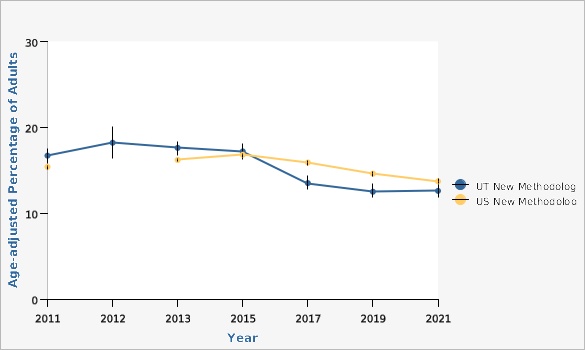Why Is This Important?
Fruits, as well as vegetables, contain essential vitamins, minerals, fiber, and other compounds that may help prevent many chronic diseases. Compared with people who consume a diet with only small amounts of fruits and vegetables, those who eat more generous amounts as part of a healthful diet are likely to have reduced risk of chronic diseases, including stroke and perhaps other cardiovascular diseases, and certain cancers^1^. Fruits and vegetables also help people to achieve and maintain a healthy weight because they are relatively low in energy density^2^. To promote health and prevent chronic diseases, the 2020-2025 Dietary Guidelines for Americans recommend two cups of fruit per day for a standard 2,000 calorie diet, with recommendations based on an individual's age, gender, and activity level^3^.
[[br]][[br]]
----
1. CDC. ''Can eating fruits and vegetables help people to manage their weight?'' [http://www.cdc.gov/nccdphp/dnpa/nutrition/pdf/rtp_practitioner_10_07.pdf/ (Research to Practice Series No. 1)] [[br]]
2. CDC. [https://www.cdc.gov/nccdphp/dnpa/nutrition/pdf/r2p_energy_density.pdf/ "Low-Energy-Dense Foods and Weight Management: Cutting Calories While Controlling Hunger." ] [[br]]
3. U.S. Department of Agriculture and U.S. Department of Health and Human Services. Dietary Guidelines for Americans, 2020-2025. 9th Edition. December 2020. Available at DietaryGuidelines.gov.Vegetables Consumed Three or More Times Per Day, Utah and U.S., 2011-2021 (Odd Years) |
The percentage of adults consuming three servings of vegetables per day have had a slight downward trend for both Utah and the U.S. since 2011.
Data are collected in odd years.
Data Sources
- The Utah Department of Health and Human Services Behavioral Risk Factor Surveillance System (BRFSS)
- Behavioral Risk Factor Surveillance System Survey Data, US Department of Health and Human Services Centers for Disease Control and Prevention (CDC).
Data Notes
In 2011, the BRFSS changed its methodology from a landline only sample and weighting based on post-stratification to a landline/cell phone sample and raking as the weighting methodology. Raking accounts for variables such as income, education, marital status, and home ownership during weighting and has the potential to more accurately reflect the population distribution. Due to changes in both sampling and the vegetable consumption question format, 2011 data should not be compared to previous years.
U.S. data do not include U.S. territories, but do include District of Columbia.
Age-adjusted to U.S. 2000 standard population.Risk Factors
There is some evidence that people who develop the habit of eating fruits and vegetables early in life are likely to maintain the behavior as adults.[[br]]
[[br]]How Are We Doing?
Only 12.6% of Utah adults in 2021 reported eating vegetables three or more times a day in the past month (age-adjusted rate).What Is Being Done?
The Utah Department of Health and Human Service's Healthy Environments Active Living (HEAL) Program plays a key role in improving the health of residents in the state of Utah. The program was formed in July 2013 (as Healthy Living through Environment, Policy, and Improved Clinical Care: EPICC), through a new funding opportunity from the Centers of Disease Control and Prevention (CDC) that allowed for the merging of three previously existing programs: the Heart Disease and Stroke Prevention Program, the Diabetes Prevention and Control Program, and the Physical Activity, Nutrition and Obesity Program, as well as the addition of a school health program. HEAL was recently restructured as part of a strategic planning process and the new program model focuses on staff and partners working together to address the social determinants of health while advancing health equity and increasing policy, systems and environmental changes.
HEAL works:
In schools:[[br]]
HEAL encourages schools to adopt the Comprehensive School Physical Activity Program. This framework encourages students to be physically active for 60 minutes a day through school, home, and community activities. HEAL also tracks height and weight trends in elementary school students.
In worksites:[[br]]
HEAL offers training on developing worksite wellness programs called Work@Health. HEAL partners with local health departments to encourage worksites to complete the CDC Scorecard and participate in yearly health risk assessments for their employees. HEAL provides toolkits and other resources for employers interested in implementing wellness programs [https://heal.health.utah.gov/worksite-wellness/ Worksite Wellness].
In communities:[[br]]
HEAL receives federal funding to partner with worksites and community-based organizations to increase access to fresh fruits and vegetables in worksite and community settings. HEAlL also partners with LHDs to work with cities and/or counties within their jurisdictions to create a built environment that encourages physical activity.
In healthcare:[[br]]
HEAL works with health care systems to establish community clinical linkages to support individuals at risk for or diagnosed with diabetes or hypertension to engage in lifestyle change programs such as chronic disease self-management and diabetes prevention programs.
In childcare:[[br]]
HEAL works with state and local partners through the Childcare Obesity Prevention workgroup to implement policy and systems changes in early care and education across agencies statewide. Ten local health departments statewide have implemented the TOP Star program, which aims to improve the nutrition, physical activity, and breastfeeding policies and environments and achieve best practices in childcare centers and homes.[[br]]Healthy People Objective: Increase the variety and contribution of vegetables to the diets of the population aged 2 years and older
U.S. Target: Not applicable, see subobjectives in this category
Date Indicator Content Last Updated: 11/01/2022
Other Views
- Utah and U.S., 2011-2021 (Odd Years)
- by Race, Utah Adults Aged 18+, 2019 & 2021
- by Ethnicity, Utah Adults Aged 18+, 2021
- by Local Health District, Utah, 2019 & 2021
- by Age and Sex, Utah, 2021
- by Utah Small Area, 2013, 2015, 2017, 2019, 2021
- by Income, Utah, 2021
- by Education, Utah, 2021

